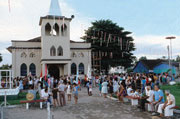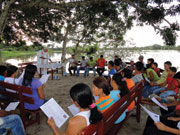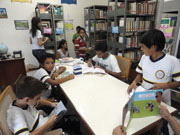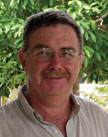Mission to Painted Rock
50 years of Scarboro Missions’ presence in the Amazon
1961-2011
By Fr. Ron MacDonell, S.F.M.
January/February 2011
Return to Table of Contents
Print Article
In October 1961, at St. Michael’s Cathedral in Toronto, five young Canadian priests were missioned to the Brazilian Amazon. They were Scarboro priests Michael O’Kane, Vincent Daniels, Douglas MacKinnon, Paul McHugh and George Marskell. The latter two would eventually become the first two bishops of the Prelacy of Itacoatiara, a name meaning “Painted Rock” in the Tupi language. The term “Prelacy” refers to a new church region assigned to a religious congregation until it is sufficiently autonomous (i.e. with local clergy) to merit the status of “Diocese.”
 (Credit: David Eijsenck)
(Credit: David Eijsenck)The church of Itacoatiara today. The first Scarboro mission team to Brazil arrived here in 1961 to walk with the people.
The newly-formed Prelacy was 274 kilometres east of Manaus, the jungle’s main city. The neophyte mis-sioners travelled by boat down the Amazon River to their new mission. At the time, a rough road was being hacked out through rainforest. Years later, the priests would recount how early attempts by jeep could take up to 24 hours, the tropical rains having turned the road into deep, muddy ruts, and how they would spend the night on the road at the mercy of mosquitoes. Now, the trip is a fast four hour drive on paved road through the jungle curves and stretches.
Bishop McHugh, ordained as bishop of the prelacy in 1965, attended the final sessions of the Second Vatican Council. The Council’s emphasis on the church as the “People of God,” and the Latin American bishops’ “preferential option for the poor” at Medellin in 1968, would determine a shift in the new missionaries’ approach. They broadened their mainly sacramental duties to include social concerns, rooted in the movement of base Christian communities (BCCs). To follow Jesus is not only to strive to live a holy personal and charitable life, it means also to work for justice, to look at the social needs of the people in the areas of land, health, education, employment, and culture and to respond to these needs. During Brazil’s brutal military dictatorship (1964-1985), these base Christian communities were often the only places where people could meet in relative freedom; political parties, workers’ unions, and all popular organization were outlawed, and many who spoke against injustices were arrested, tortured, executed, or exiled.
“The Second Vatican Council’s emphasis on the church as the “People of God,” and the Latin American bishops’ “preferential option for the poor” at Medellin, Colombia, in 1968, would determine a shift in the new missionaries’ approach.
Over the years, other priests, seminarians, and lay people from Scarboro would follow this missiological approach in Brazil. They were joined by priests and lay missionaries from a sister church, the Archdiocese of São Paulo. Pastoral commissions were created at the national level and organized in Itacoatiara as well, by missionaries and lay volunteers. The catechetical pastoral commission provided a unified approach to the reli-gious formation of children, youth, and adults. The children’s pastoral commission taught young mothers about infant care and nutrition. The pastoral commission for minors lured adolescents away from street life though alternative skills programs. The women’s pastoral commission created spaces for women to meet and talk about their concerns, often focusing on physical and sexual abuse. The Formation Centre of the Prelacy of Itacoatiara (CENTREPI) was founded, a simple structure overlooking the Amazon River where groups could meet. Celebrations of the Eucharist included songs and symbols which spoke of the people’s struggles, lamenting their pain and celebrating their victories.
 (Credit: Scarboro Missions)
(Credit: Scarboro Missions)For more than 40 years, Fr. Omar Dixon has been present in the Amazon in the Prelacy of Itacoatiara, Brazil. He is pastor of the riverside community of Itapiranga. He says, “the people in the Base Christian Communities, with their lay leaders, organize the liturgies and the pastorals (child, family, youth, catechetics, and so on) accompanied by a pastoral agent. The Prelacy currently has six Brazilian priests, four Guadalupe missionaries (Mexico), and one Scarboro priest.” Fr. Omar celebrates mass with the community of Santa Maria–Madrubá.
Itacoatiara’s second bishop, George Marskell, was appointed national vice-president of the church’s Land Pastoral Commission (CPT). The CPT worked at accompanying landless groups and fought for better land distribution. “We already have land in heaven, we want land on earth.” In the Amazon, that meant defending not just land but water and fishing rights for small communities, protecting their lakes and small rivers from over-fishing by commercial trawlers and by community members themselves.
Initially, Prelacy decisions were made by the bishop and his fellow priests. Gradually, this forum expanded to include sisters and lay representatives. Under Bishop Marskell’s leadership, a Prelacy council was organized, consisting of all missionaries (priests, sisters, lay agents) and a number of representatives from the communities. This council met three times a year to discuss Prelacy concerns and to carry out planning. Every two years, a major event was held: the Assembly of the People of God. Each of the 250 base Christian communities sent one representative to voice concerns, to celebrate victories, to debate and decide upon pastoral priorities. The last People’s Assembly was held in 1998, a month before Bishop Marskell’s premature death.
Bishop Marskell understood that any Christian social action must be centred on Jesus and rooted in prayer. In 1989, the Benedictine Sisters were invited to found the Monastery of Living Water, 10 kilometres outside Itacoatiara. Here many individuals and groups come to pray, to drink in the silence of the jungle, and to find strength in Jesus. “...Anyone who drinks the water that I shall give will never be thirsty again: the water that I give will turn into a spring inside them, welling up to eternal life” (John 4.14).
 (Credit: Scarboro Missions)
(Credit: Scarboro Missions)The children’s lending library at the Dom Jorge Marskell Association. Top right: Dona Sylvia Aranha de Oliveira, president of the Association, with Fr. Ron MacDonell. Dona Sylvia has worked in the Prelacy of Itacoatiara for the last 40 years as a pastoral agent.
Only one Scarboro missionary remains in the Prelacy of Itacoatiara: Fr. Omar Dixon, a native of Dingwall, Cape Breton. Parish priest downriver in Itapiranga for the last 26 years, and soon to turn 70, he has many stories to tell about his missionary life, particularly about the years he lived on a Prelacy boat upriver. Stories, indeed, that all 23 of us Scarboro missionaries could tell: tales of storms and boat mishaps, illnesses and recoveries, confrontations with corrupt authorities, but also tales of great joy, of friendship with the people, of finding Christ in this Amazonian church. “The desert is fertile” wrote the prophet Archbishop Dom Helder Câmara. So, too, is the jungle, as witnessed by Scarboro missionaries—fertile with love of God and thirst for justice.
Fr. Ron MacDonell worked in the Prelacy of Itacoatiara from 1986-1992 as parish priest of Urucará and São Sebastião do Uatumã. Currently he lives in Boa Vista, in the state of Roraima, and serves as linguistic resource person for CIMI (the Missionary Indigenist Council), accompanying indigenous groups in Amazonas and Roraima in language revitalization work.
Dom Jorge Marskell Association
Since 2001, volunteers aim to continue social outreach in the spirit of Scarboro missionary Bishop George Marskell (1935-1998) through a children’s lending library, music classes (flute, choral, and guitar), legal aid for poor people provided by volunteer lawyers, and other community programs. Donations can be made to the Association through Scarboro Missions. On June 5, 1998, Bishop George said to the People’s Assembly of the Prelacy of Itacoatiara: “I know that all of you believe with me that our church is, and tends to be, more and more participative, more and more a church of solidarity. Only so can we become a church with the face of Jesus.” These words are printed on his burial stone.
Scarboro missionary appointments to the Prelacy of Itacoatiara, Brazil
| 1961 | Vincent Daniel Douglas MacKinnon George Marskell Paul McHugh Michael O’Kane |
| 1963 | Timothy Ryan William Smith |
| 1966 | Lewis Hewer |
| 1964 | Justin MacInnis Raymond O’Toole |
| 1968 | Omar Dixon Hubert Den Tandt Bryan Manning |
| 1970 | Terence O’Sullivan Malcolm Burke Chester Gabriel |
| 1974 | Alan King |
| 1977 | Gregory Morrison |
| 1980 | Marlene Bourdeau |
| 1986 | Ronald MacDonell |
| 1988 | Timothy Charrette |
| 1993 | Mark Donagher |
| 1995 | Paul McGuire Karen Van Loon |
| 2003 | Beverley Trach |
Return to Table of Contents
Print Article
